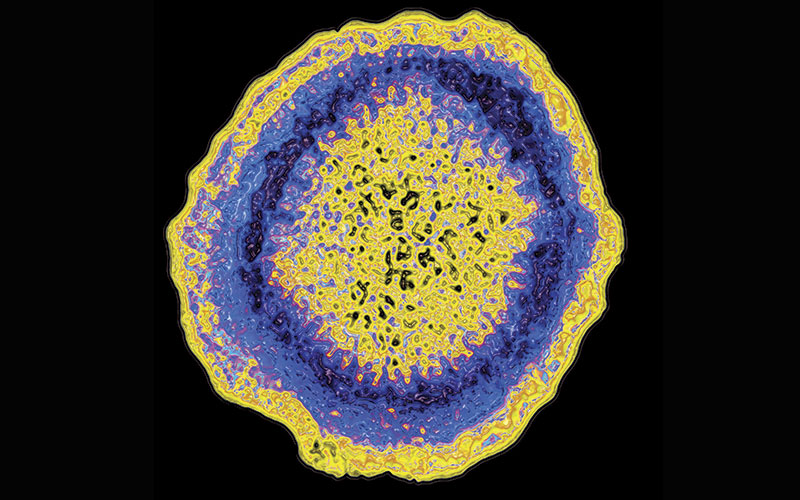The hard copy of the autumn issue of our journal is complete. Editor Andrew Blann outlines the content of the latest issue, which includes six papers that use techniques in molecular genetics.

Liver Disease
Hepatitis C virus infection is a major problem in many parts of the world and in many cases leads to hepatocellular carcinoma (HCC). Attallah and colleagues (pages 157-162) studied 500 subjects infected with the virus, reporting that those with certain SNPs in IL28B are at risk of developing liver fibrosis, cirrhosis and HCC, suggesting that knowledge of these genotypes may help diagnosis and target treatment. El-Bendary et al. (pages 175-181) also looked at SNPs in chronic hepatitis C virus infection, finding that certain alleles in genes for Toll-like receptors (TLRs) 3, 4 and 7 seem to confer protection from, or predispose to, chronic infection with the virus.
The MELD score, derived from bilirubin, INR and creatinine, aims to quantify the severity of liver disease. Elalfy and colleagues (pages 187-191) hypothesised that any one of a series of full blood count indices, and their combinations, could predict the recurrence of hepatocellular carcinoma after a form of treatment – transarterial chemoembolization. They found that the granulocyte/monocyte to lymphocyte ratio is comparable to the MELD score in predicting recurrence – interesting news for the haematology lab! Chronic hepatitis B virus (HBV) infection often leads to cirrhosis and carcinoma, but the process is unclear. Mousa and colleagues (pages 192-196) hypothesised links between serum leptin and the homeostasis model of insulin resistance (HOMA-IR), and liver fibrosis in a group with chronic HBV infection. Unlike routine LFTs (all of which were of course, abnormal), both HOMA-IR and leptin were significant independent predictors of HBV infection, and leptin correlated very strongly with the degree of fibrosis, point to value as a diagnostic and staging marker.
Non-alcoholic fatty liver disease (NAFLD) is a common form of chronic liver disease worldwide, but knowledge of its impact into pregnancy is incomplete. Mousa et al (pages 197-199) found that pregant women with NAFLD were more likely to have gestational diabetes, pre-eclampsia, and raised AST, total cholesterol and uric acid than pregnant women free of NAFLD.
Gastric and Cervical Cancer
Although gastric cancer is a common malignancy, there are no reliable blood markers.
Zhao et al (pages 203-205) tested the hypothesis of a link between serum soluble major histocompatibility complex class I-related chain A (sMICA) and clinicopathological features in gastric cancer, finding levels to be higher in the disease, and that such levels were linked to metastases and 5-year survival outcome. Could sMICA be the first blood test in this disease?
A common problem with the chemo- and radiotherapy of cervical is toxicity towards certain organs and tissues, believed to be due to reactive oxygen species (ROS). Abbas et al (pages 169-174) report that certain SNPs in the gene for an antioxidant enzyme, glutathione S-transferase, theoretically protective of these metabolic toxins, are linked to the likelihood of severe gastrointestinal toxicity, once more pointing to value in diagnosis and management. MicroRNAs (miRNAs) are small ribonucleic acid heteropolymers, STAT3 is a signal transduction factor that passes activation messages to the nucleus: both are linked to malignancy. Mirnoori and colleagues (pages 182-186) hypothesised alterations in pri-miR-124-1 and STAT3 in 250 gastric cancer patients and 310 controls, finding that certain SNPs are indeed linked to the disease.
Microbiology, Diabetes and Immunology
Although the leading aetiology of diabetes is obesity and hypergylcaemia, these do not account for all disease as several genes are implicated. In a study of 250 diabetics, Abbas and colleagues (pages 163-168) also looked for SNPs in the gene for TLR4, and found links with three common co-morbidities – hypertension, nephropathy and/or dyslipidemia - again suggesting the analysis of these SNPs may help diagnosis and management. Since cell-surface TLRs are part of the innate immune system, recgonthis report supports the hypothesis of inflammation and diabetes.
Few of use can be unaware of the growing problem of microbial resistance to antibiotics, and extended spectrum beta lactamase [ESBL] producers and ESBL associated cephalosporin resistance among Acinetobacter baumannii is emerging.
Smiline and colleagues (pages 200-202) analysed the distribution of certain plasmid encoded beta-lactamase genetic determinants likely to be linked to resistance, in 73 isolates. They found blaTEM and blaSHV in 57.5% and 6.8% respectively, but none of the strains showed the presence of blaCTX-M, pointing the way to those seeking a panel of genes in this setting.
Bactericidal/permeability-increasing protein (BPI) is one of the antigens recognised by anti-neutrophil cytoplasmic antibodies (ANCA). Tian and colleagues (pages 206-208) hypothesised a role for these antibodies in chronic obstructive pulmonary disease (COPD). Lung function tests were worse in BPI-ANCA(+) patients, who also had longer disease duration and history of hospitalisation. In 12 and 18 months of follow-up, all clinical indices had deteriorated more in the presence of the antibodies, a finding that be used to help drive treatment and subsequent monitoring.
Andrew Blann is the Editor of the British Journal of Biomedical Science
One or more of these articles may be the subject of a Journal-based learning exercise for those seeking to improve their continuing professional development profile.
Image Credit | Science Photo Library




